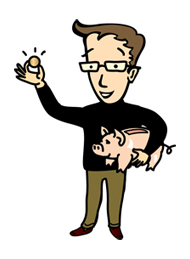Let’s assume you are publishing a simple book that is 6″x9″, 250 page, B&W interior, full-color cover. The cover price is $19.99. This is the same example used in part one of The Math Publishers Don’t Want Authors to Know!
When do you start making a profit?
You only have to sell around 270 books to cover all your start up cost. That’s all—even though you’re following publisher best practices by actually hiring a professional editor and designer! Sell just 270 books and then you’re on your way to making a profit.
The initial costs (editing, design, etc), plus the first 300 printed books look like this:
300 x $19.99 = $5,997
Editor $1,500
Pre-press $2,280 (Design, page layout, file prep)
Printing and shipping $1,620 (The POD print unit costs is $5.40. 300 x $5.40 = $1,620)
Total cost $5,400
$5,997 – $5,400 = $597 divided by 19.99 = 30 copies
300 – 30 = 270 copies to break even.
$5400 divided by the cover price $19.99 equals only 270 books sold before you start making a profit. (This assumes the books are ordered and shipped 100 copies at a time. If for example, all 300 books were ordered at once, the print costs drop to $1441.93. This slight savings changes the equation like this: $3780 + $1441.93 = $5221.93 divided by $19.99. Now only 261 books need to be sold before making a profit.)
After selling 270 books, your only remaining costs are printing and shipping more books to your office. The next 300 books (ordered 100 at a time) costs $1620.27. Sold at $19.99 each, the total income is $5,997, leaving a profit of $4,376.73. Remember, when the publisher sold 600 copies, you made only around $420. In fact, with 4000 books sold by the publisher, you only made around $2800. To make the same amount, you only have to sell 463 books, which is 3,537 fewer books than the publisher! If you publish independently and sell 4000 books, you get $54,576.40!
What if you sell more than 4000 books?
Let’s assume the book is a great success and you start selling more than 4,000 copies. Here’s the math based on the model outlined above (initial costs of $3780, plus low-risk print-on-demand method for 100 books ordered at a time costing $540).
Net profit after costs:
4,000 books sold = $54,576.40
10,000 books sold = $145,891
100,000 books sold = $1,458,910
If the book proves too difficult to sell, you can cut your losses early by not ordering more books. However, because you only need to sell around 270 copies to cover your costs, it is unlikely you will lose money.
Let’s now assume that you want better printing. Instead of print-on-demand, you decide to use offset printing to get better overall quality and more special print features, such as a gate-fold cover (French flaps), a metallic ink or gold foil title, embossing, a second color in the interior, etc. Unlike print-on-demand, you need to print more copies, usually more than 1000 copies to make it worthwhile, so you have to invest more money up front, but bear in mind that the total overall investment is less, even though you are getting much higher quality.
You decide to spend $12,000 on printing 4000 copies. With the similar editing, design, and a few additional costs (special effects templates and print management), the total investment is now $16,000 or $4.00 per book. Profit per book is $15.99, almost 15% higher than when using print-on-demand. You now make 15% more and the book is a much better quality product that will be much more likely to make a good impression and sell.
$16,000 divided by $19.99 means 801 books must be sold before profitability.
This leaves 3,199 books in your inventory. 3,199 books sold at $19.99 = $63,948.01 total profit. This is $9371.61 more profit than you made selling the print-on-demand books.
When many people think about profits from publishing, they are only looking at the book sales. For business owners and entrepreneurs, the profits from the book sales are often just the beginning. In fact, some businesses and entrepreneurs can profit from publishing even if they give away the books. Be sure to see read my post Benefits of Publishing for Businesses and Entrepreneurs and The Most Important Thing to Do When Publishing.
